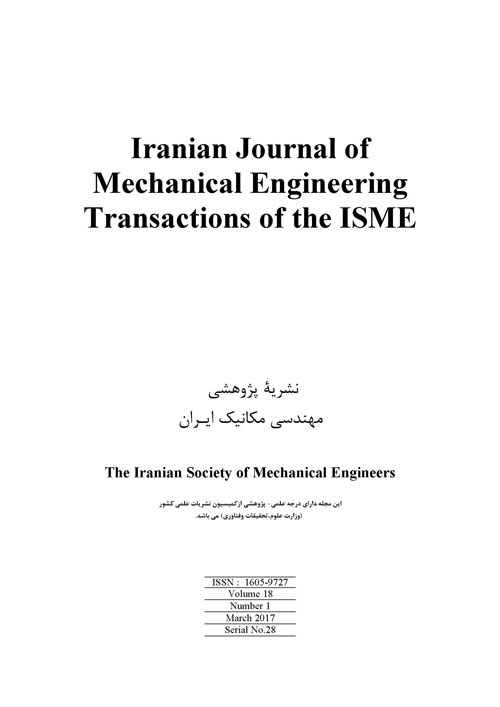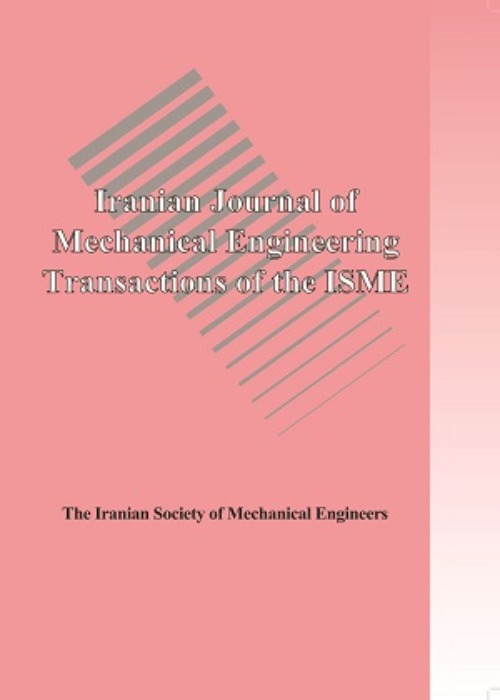فهرست مطالب

Iranian Journal of Mechanical Engineering Transactions of ISME
Volume:18 Issue: 1, Mar 2017
- تاریخ انتشار: 1396/09/30
- تعداد عناوین: 5
-
-
Pages 5-42In this work, analytical solutions are provided to the nonlinear equations arising in thermal and flow-induced vibration in fluid-conveying structures using Galerkin-differential transformation method with cosine aftertreatment technique. From the analysis, it was established that increase of the length and aspect ratio of the fluid-conveying structures result in decrease the nonlinear vibration frequencies of the structure while increase in the fluid-flow velocity causes increase in nonlinear vibration frequencies of the structures. Also, increase in the slip parameter leads to decrease in the frequency of vibration of the structure and the critical velocity of the conveyed fluid while increase in the slip parameter leads to decrease in the dimensionless frequency ratio of vibration of the structure. As the Knudsen number increases, the bending stiffness of the nanotube decreases and in consequent, the critical continuum flow velocity decreases as the curves shift to the lowest frequency zone. Good agreement are established when the results of the differential transformation method are compared with the results of the numerical method and exact analytical method for the non-linear and linear models, respectively.Keywords: Non, linear Vibration, Galerkin's method, Differential Transformation method, Cosine, Aftertreatment techniques, Fluid, conveying structures
-
Pages 43-64In this work, analysis of transient three-dimensional heat transfer in a slab with internal heat generation and heated by a point moving heat source along its axis is carried out using integral transforms methods. The heat input into slab or workpiece by the moving heat source is considered in the model. From the results, it was established that the temperature of the material during the heat transfer process decreases while the time required to reach the peak temperature increases with increasing distance from the centerline. Also, the rate of heating and the rate of cooling decrease with increasing distance from the centerline. The computed results at different monitoring locations show typical features of the temperature profiles and they afford a close analysis of the factors governing the heat flow in a point moving heat source.Keywords: Transient heat transfer, Three, dimensional model, Point Moving heat source, Integral transforms, Analytical solutions
-
Influence of Biodiesel from Egyptian Used Cooking Oils on Performance and Emissions of Diesel EnginePages 65-80Due to diminishing petroleum reserves and the environmental negative effects of exhaust gases from diesel engines, alternative fuels for diesel engines are becoming increasingly important Egyptian waste cooking oils have special specifications because it expose to high temperatures during use for long hours. In the present experimental study, the performance and emissions of a four strokes, single cylinder, air cooled diesel engine fuelled with two different biodiesel from Egyptian used cooking oil (palm and sunflower) are evaluated at different speeds. The measured performance parameters include torque, fuel consumption and exhaust gas temperature. Brake power, brake specific fuel consumption and brake thermal efficiency was calculated using the measured test data The emission parameters include carbon monoxide, particulate matter and the oxides of nitrogen. The tests have been carried out with different blends of B5 to B100 of biodiesel with diesel fuel. The results showed that the engine performance with the palm biodiesel blend B5 is closed to diesel fuel also, for B5 CO emission decreased from 53 to 70% while NOx emission decreased from 13 to 80% compared to diesel fuel.Keywords: Diesel engine, biodiesel, Egyptian used cooking oils, engine performance, emissions
-
Pages 81-102In this research, the behavior and characteristics of the wake of flow in an elliptic cylinder with zero angle of attack in the presence of a tripping wire were investigated experimentally. For this purpose, the used an Aluminum cylinder with an elliptical cross section of the major and minor axis of 42.4 mm and 21.2 mm, respectively, and of the height of 390 mm. The cylinder model was examined in the test section of a blower type wind tunnel. The Reynolds numbers of the experiment for the major axis are 25700 and 51400 for 10 m/s and 20 m/s speeds, respectively. Tripping wires of the diameter of 0.5 mm, 1 mm, and 1.5 mm placed symmetrically at both sides of the cylinder, each are tested at angles of zero, 23.7, and 40.9 degrees with respect to the stagnation point. The drag coefficient for the smooth cylinder for either of the Reynolds numbers is about 0.6. The results indicate that in the best possible case, the drag coefficient for the 0.5 mm wire reduces by 75%.Keywords: Trip wire, Drag coefficient, Wake of elliptic cylinder, Hot wire anemometry
-
Pages 103-123Based on elasticity approach, 1D analytical method is adopted in radial direction to analyze spherical shell made of FGPM. The mechanical properties are regulated by volume fraction as a function of radial coordinate. Loading can be internal and external pressures, or electric field. All mechanical and piezoelectric properties except the Poissons ratio are assumed to be power functions of radius. The 3D governing equations are reduced to a 1D second order nonlinear differential equation in terms of radial displacement, which then is solved analytically. By satisfying four different sets of boundary conditions and incorporating them into governing equation, a system of algebraic equations is obtained that delivers the unknown constants. Static responses of FG shell to electro-mechanical loads with different powers of material in-homogeneity n as well as the effects of size are investigated. The accuracy and computational efficiency of the proposed approach are verified by comparing the results with those obtained for homogenous material in the literature. The induced stresses are compared to the residual stresses locked in the homogeneous sphere.Keywords: Functionally graded material, Piezoelectric material, Sphere, Elasticity solution, Nonlinear differential equation


